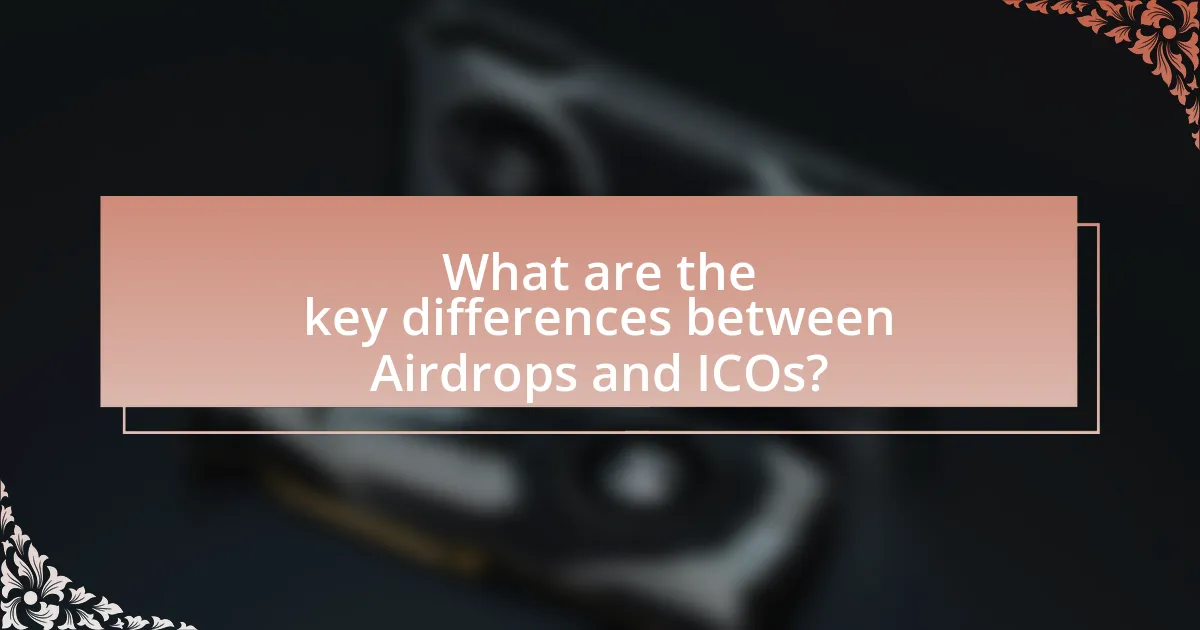The article focuses on comparing airdrops and Initial Coin Offerings (ICOs) as investment opportunities in the cryptocurrency market. It defines airdrops as a method of distributing free tokens to promote projects or reward users, while ICOs are fundraising mechanisms where investors purchase tokens to support new projects. Key aspects discussed include the functioning of airdrops, their various types, and the requirements for participation, alongside the ICO process, stages, and investor participation. The article also highlights the differences in risks and rewards associated with both options, providing insights into factors investors should consider when choosing between airdrops and ICOs, as well as strategies for maximizing benefits and avoiding common pitfalls.

What are Airdrops and ICOs?
Airdrops are a method of distributing cryptocurrency tokens to multiple wallet addresses, often for free, as a way to promote a new project or reward existing users. ICOs, or Initial Coin Offerings, are fundraising mechanisms where new cryptocurrencies sell their tokens to investors, typically in exchange for established cryptocurrencies like Bitcoin or Ethereum, to raise capital for development. Airdrops can serve as marketing tools to increase awareness and user engagement, while ICOs provide a structured way for projects to secure funding, with the potential for investors to gain early access to new tokens.
How do Airdrops function in the cryptocurrency ecosystem?
Airdrops function in the cryptocurrency ecosystem by distributing free tokens or coins to holders of a specific cryptocurrency, often as a marketing strategy to promote a new project or increase user engagement. This process typically requires users to hold a certain amount of an existing cryptocurrency in their wallets at a designated time, known as the snapshot date. For example, in 2020, the Uniswap platform airdropped its governance token, UNI, to users who had previously interacted with the platform, distributing a total of 1 billion tokens. Airdrops can also involve users completing specific tasks, such as following social media accounts or joining community groups, to qualify for the free tokens. This method not only incentivizes participation but also helps to create a wider distribution of the new cryptocurrency, enhancing its visibility and potential adoption in the market.
What are the different types of Airdrops?
There are several types of airdrops, including standard airdrops, holder airdrops, bounty airdrops, and exclusive airdrops. Standard airdrops distribute tokens to users who sign up or complete specific tasks, while holder airdrops reward existing token holders based on their current holdings. Bounty airdrops incentivize users to promote a project through social media or other activities, and exclusive airdrops are targeted at specific groups, such as early investors or community members. Each type serves different purposes in promoting projects and engaging users in the cryptocurrency ecosystem.
What are the typical requirements for participating in Airdrops?
To participate in airdrops, individuals typically need to hold a specific cryptocurrency in their wallets, complete certain tasks such as following social media accounts, or register on a platform. These requirements ensure that participants are engaged and often help promote the project. For example, many airdrops require users to have a minimum balance of a particular token to qualify, which can be verified through blockchain records. Additionally, tasks like sharing posts or joining community groups are common, as they increase the project’s visibility and user engagement.
What is the process of an Initial Coin Offering (ICO)?
The process of an Initial Coin Offering (ICO) involves several key steps. First, a company creates a whitepaper that outlines the project’s goals, technology, and tokenomics. This document serves as a blueprint for potential investors. Next, the company promotes the ICO through marketing campaigns to attract interest and build a community around the project.
Once the ICO is launched, investors can purchase tokens using cryptocurrencies, typically Bitcoin or Ethereum, during a specified period. The funds raised are often used for project development and operational costs. After the ICO concludes, the tokens are distributed to investors, and they may be listed on cryptocurrency exchanges for trading.
This process has been validated by numerous successful ICOs, such as Ethereum’s ICO in 2014, which raised over $18 million, demonstrating the effectiveness of this fundraising method in the blockchain space.
What are the stages involved in an ICO?
The stages involved in an Initial Coin Offering (ICO) include the following: pre-ICO, ICO launch, and post-ICO. During the pre-ICO stage, the project team prepares marketing materials, whitepapers, and sets the token price. The ICO launch stage involves the actual sale of tokens to investors, often accompanied by promotional activities to attract participants. Finally, the post-ICO stage focuses on delivering the promised product or service, managing the community, and ensuring compliance with regulations. These stages are critical for the successful execution and sustainability of the ICO process.
How do investors participate in an ICO?
Investors participate in an Initial Coin Offering (ICO) by purchasing tokens directly from the project team in exchange for cryptocurrency, typically Bitcoin or Ethereum. During the ICO, investors send their chosen cryptocurrency to a specified wallet address provided by the project, and in return, they receive the newly issued tokens at a predetermined rate. This process is often facilitated through a website or platform dedicated to the ICO, where investors can find details about the project, tokenomics, and the timeline for the offering. The ICO model allows projects to raise funds for development while giving investors early access to potentially valuable tokens.

What are the key differences between Airdrops and ICOs?
Airdrops and Initial Coin Offerings (ICOs) differ primarily in their distribution methods and objectives. Airdrops involve distributing free tokens to holders of an existing cryptocurrency, often as a marketing strategy to increase awareness or user engagement, while ICOs are fundraising mechanisms where investors purchase tokens in exchange for established cryptocurrencies, typically to support a new project or platform. Airdrops usually require minimal participation, such as holding a specific token, whereas ICOs necessitate financial investment and often involve detailed project information and regulatory compliance.
How do the investment risks compare between Airdrops and ICOs?
Airdrops generally present lower investment risks compared to Initial Coin Offerings (ICOs). Airdrops typically distribute tokens for free or in exchange for minimal tasks, reducing the financial commitment and potential loss for investors. In contrast, ICOs require substantial monetary investment upfront, often leading to significant financial risk, especially given the high failure rate of projects; research indicates that approximately 90% of ICOs fail within four years. Additionally, ICOs are more susceptible to regulatory scrutiny and fraud, which can further elevate risks for investors.
What are the potential losses associated with Airdrops?
Potential losses associated with airdrops include the risk of receiving worthless tokens, exposure to scams, and the potential for tax liabilities. Airdropped tokens may lack utility or market demand, leading to a decline in value. Additionally, some airdrops are associated with fraudulent schemes that can compromise personal information or lead to financial loss. Furthermore, in many jurisdictions, receiving airdropped tokens can trigger tax obligations, resulting in unexpected financial liabilities for the recipient.
What are the risks investors face during an ICO?
Investors face several risks during an Initial Coin Offering (ICO), including regulatory uncertainty, project viability, and potential for fraud. Regulatory uncertainty arises because many jurisdictions have not established clear guidelines for ICOs, leading to the possibility of legal repercussions for investors if the offering is deemed illegal. Project viability is a significant concern, as many ICOs are launched by startups with unproven business models, which can result in project failure and loss of investment. Additionally, the potential for fraud is high, as some ICOs may be scams designed to mislead investors and abscond with their funds. According to a report by the Blockchain Transparency Institute, approximately 80% of ICOs launched in 2017 were found to be scams, highlighting the prevalence of fraudulent activities in this space.
What are the potential rewards of Airdrops versus ICOs?
Airdrops can provide immediate token distribution to users without requiring an upfront investment, while ICOs typically offer early access to tokens at a potentially lower price before they are publicly traded. Airdrops reward users for holding existing tokens or participating in community activities, which can lead to quick gains if the tokens appreciate in value. In contrast, ICOs often promise higher returns if the project succeeds, as investors can acquire tokens before they hit the market. Historical data shows that some ICOs have generated significant returns, with projects like Ethereum seeing over 13,000% gains from their ICO price. However, airdrops can also lead to substantial profits, as seen with projects like Uniswap, which rewarded users with governance tokens that surged in value shortly after distribution.
How can Airdrops lead to profit for investors?
Airdrops can lead to profit for investors by providing free tokens that may appreciate in value over time. When a project distributes tokens through an airdrop, investors receive these tokens without any financial investment, allowing them to potentially sell the tokens later at a higher market price. For instance, the 2017 airdrop of OmiseGO distributed tokens to Ethereum holders, resulting in significant price increases, with the token reaching an all-time high of $25. This demonstrates how airdrops can create immediate value for investors, as they can capitalize on market demand for the newly distributed tokens.
What returns can investors expect from ICOs?
Investors can expect variable returns from Initial Coin Offerings (ICOs), often ranging from substantial gains to significant losses. Historical data shows that some ICOs have yielded returns exceeding 1,000% shortly after launch, while others have resulted in total loss of investment. For instance, the Ethereum ICO in 2014 provided early investors with returns of over 10,000% by 2021. Conversely, many ICOs have failed, with reports indicating that approximately 80% of ICOs launched in 2017 were deemed unsuccessful or fraudulent, leading to losses for investors. Therefore, while the potential for high returns exists, the risks associated with ICO investments are considerable.

Which option is more beneficial for investors?
Airdrops are generally more beneficial for investors compared to ICOs. Airdrops provide free tokens to participants, allowing investors to gain exposure to new projects without financial risk. In contrast, ICOs require upfront investment, which can lead to significant losses if the project fails. Historical data shows that many ICOs have resulted in substantial financial losses for investors, while airdrops have allowed participants to accumulate tokens with no initial cost, thus minimizing risk.
What factors should investors consider when choosing between Airdrops and ICOs?
Investors should consider the potential for returns, risk levels, regulatory compliance, and project credibility when choosing between Airdrops and ICOs. Airdrops typically involve receiving free tokens, which can provide low-risk exposure to new projects, while ICOs require upfront investment, presenting higher risk but potentially greater returns if the project succeeds. Regulatory compliance is crucial, as ICOs often face stricter scrutiny compared to Airdrops, which may operate in a more ambiguous legal environment. Additionally, the credibility of the project team and their track record can significantly influence the likelihood of success, making it essential for investors to conduct thorough research on both options.
How does market volatility impact Airdrops and ICOs?
Market volatility significantly impacts Airdrops and ICOs by influencing investor sentiment and participation rates. During periods of high volatility, investors may become more risk-averse, leading to decreased interest in participating in ICOs, which are often perceived as high-risk investments. For instance, a study by CoinDesk in 2020 indicated that ICOs raised 95% less capital during volatile market conditions compared to stable periods. Conversely, Airdrops can attract more participants during volatile times as they offer free tokens, reducing the financial risk for investors. This dynamic can lead to increased engagement in Airdrops even when ICOs struggle to gain traction.
What role does project credibility play in investor decisions?
Project credibility significantly influences investor decisions by establishing trust and perceived value in a project. When investors assess a project, they prioritize its credibility, which is often determined by factors such as the team’s experience, transparency, and past performance. For instance, a study by the Cambridge Centre for Alternative Finance found that projects with credible teams and clear communication strategies raised 50% more funds compared to those lacking such attributes. This correlation highlights that higher project credibility leads to increased investor confidence, ultimately affecting funding outcomes and investment choices.
What strategies can investors use to maximize benefits from Airdrops and ICOs?
Investors can maximize benefits from airdrops and ICOs by conducting thorough research, diversifying their investments, and actively participating in community engagement. Conducting thorough research involves analyzing the project’s whitepaper, team credentials, and market potential, which helps investors identify promising opportunities. Diversifying investments across multiple airdrops and ICOs reduces risk and increases the chances of capitalizing on successful projects. Actively participating in community engagement, such as joining social media channels and forums, allows investors to stay informed about updates and potential opportunities, enhancing their ability to make timely decisions. These strategies are supported by the fact that informed investors are more likely to recognize valuable projects, as evidenced by the success rates of well-researched investments in the cryptocurrency space.
How can investors effectively research Airdrop opportunities?
Investors can effectively research airdrop opportunities by utilizing multiple online resources and platforms that aggregate information about upcoming and ongoing airdrops. Key methods include following reputable cryptocurrency news websites, joining dedicated forums and social media groups, and subscribing to newsletters that focus on cryptocurrency developments. For instance, websites like CoinMarketCap and AirdropAlert provide comprehensive lists of airdrops, including details on eligibility and deadlines. Additionally, engaging with community discussions on platforms like Reddit and Telegram can yield insights and firsthand experiences from other investors. This multifaceted approach ensures that investors stay informed about legitimate airdrop opportunities while avoiding scams.
What best practices should be followed when participating in ICOs?
When participating in ICOs, investors should conduct thorough research on the project, including its whitepaper, team credentials, and market potential. This practice ensures that investors understand the project’s goals, technology, and the problem it aims to solve. Additionally, investors should verify the legitimacy of the ICO by checking for regulatory compliance and community feedback, as fraudulent projects have been prevalent in the ICO space. According to a report by the Blockchain Research Institute, over 80% of ICOs launched in 2017 were deemed scams, highlighting the importance of due diligence. Furthermore, investors should only invest what they can afford to lose, as the volatility in the cryptocurrency market can lead to significant financial risks. Following these best practices can help mitigate risks associated with ICO investments.
What are the common pitfalls to avoid in Airdrops and ICOs?
Common pitfalls to avoid in Airdrops and ICOs include lack of thorough research, falling for scams, and ignoring regulatory compliance. Investors often neglect to investigate the project’s team, technology, and market potential, which can lead to poor investment decisions. Scams are prevalent in the cryptocurrency space; thus, verifying the legitimacy of the project and its team is crucial. Additionally, failing to comply with regulations can result in legal issues, as seen in cases where projects faced penalties for not adhering to securities laws. These pitfalls highlight the importance of due diligence and awareness in the investment process.
What scams should investors be aware of in Airdrops?
Investors should be aware of several scams associated with airdrops, including phishing scams, fake airdrops, and wallet draining. Phishing scams often involve fraudulent websites or communications that mimic legitimate projects, tricking investors into providing private keys or sensitive information. Fake airdrops promise free tokens but require participants to send funds upfront, which they never receive. Wallet draining scams exploit vulnerabilities in wallets or require users to approve malicious transactions, leading to loss of funds. According to a report by CipherTrace, over $1.9 billion was lost to cryptocurrency scams in 2020, highlighting the prevalence of such fraudulent activities in the crypto space.
How can investors identify red flags in ICOs?
Investors can identify red flags in ICOs by scrutinizing the project’s whitepaper, team credentials, and community engagement. A poorly written or vague whitepaper often indicates a lack of transparency and planning, while a team with unverifiable or questionable backgrounds raises concerns about their capability to execute the project. Additionally, low community engagement or negative sentiment on social media platforms can signal potential issues, as active and supportive communities typically reflect a project’s credibility. Historical data shows that many failed ICOs exhibited these characteristics, reinforcing the importance of thorough due diligence before investment.
How can investors make informed decisions between Airdrops and ICOs?
Investors can make informed decisions between Airdrops and ICOs by evaluating the project’s credibility, potential for growth, and the associated risks. Airdrops typically involve receiving free tokens, which can be beneficial if the project gains traction, while ICOs require an upfront investment with the potential for higher returns but also greater risk. Researching the team behind the project, their roadmap, and community feedback can provide insights into the viability of both options. Additionally, analyzing historical data, such as the success rates of past ICOs compared to the performance of tokens received from Airdrops, can further guide investors in their decision-making process.


